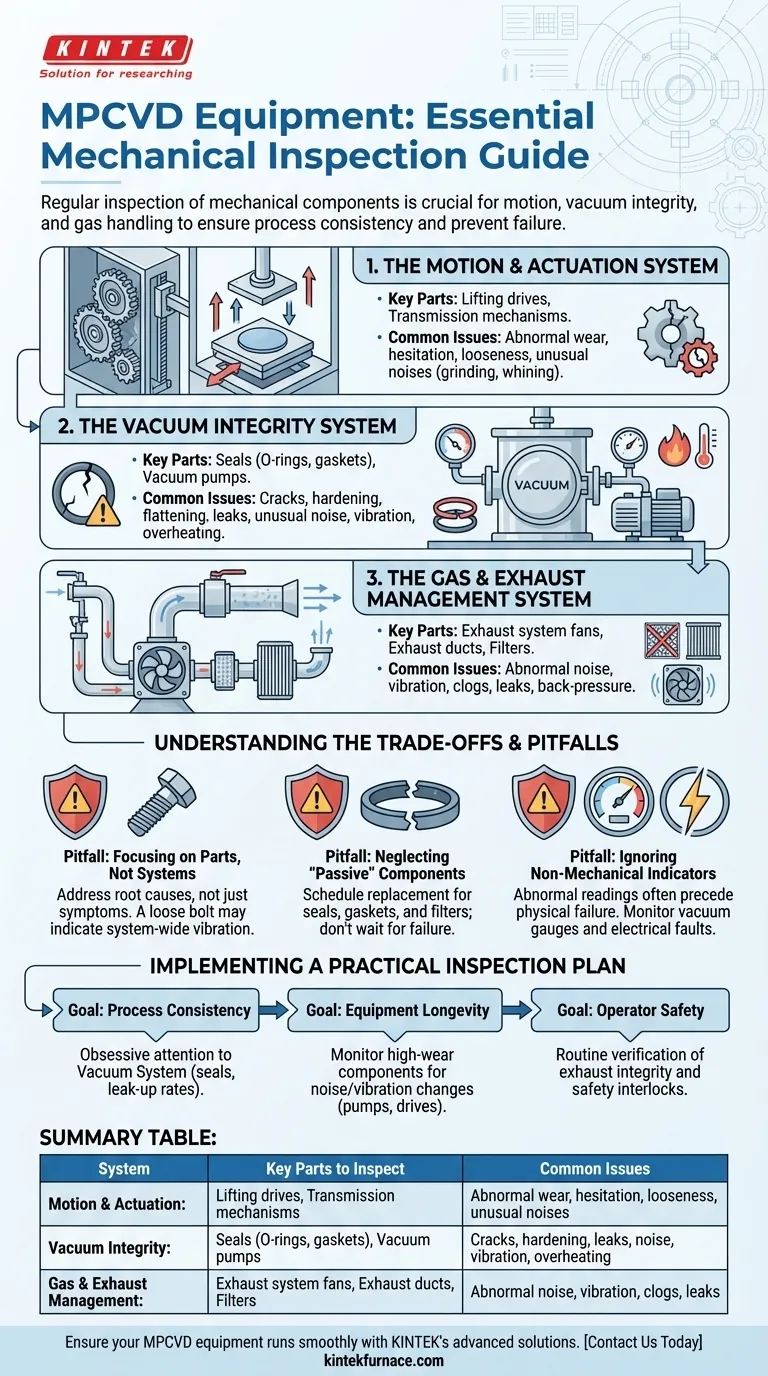At its core, regular inspection of MPCVD equipment must focus on the mechanical components responsible for motion, vacuum integrity, and gas handling. The most critical parts to check are lifting drives, transmission mechanisms, seals, vacuum pumps, and exhaust system fans, as their failure can halt production and compromise process results.
The most effective maintenance strategy goes beyond a simple checklist of parts. It involves thinking in terms of three interconnected systems: the Motion System, the Vacuum System, and the Exhaust System. A problem in one component is often a symptom of a larger issue within its system.
The Core Mechanical Systems of MPCVD
MPCVD equipment relies on the precise interaction of several mechanical systems to create the controlled environment needed for diamond growth. Regular inspection is not just about preventing failure; it's about ensuring process repeatability.
The Motion & Actuation System
This system is responsible for the precise positioning and movement of the substrate holder or other internal components.
Its smooth operation is critical for uniform deposition. Look for any signs of abnormal wear, hesitation, or looseness in its components.
Key parts include lifting drives and transmission mechanisms. Listen for unusual noises like grinding or whining, which can indicate bearing or gear wear before a catastrophic failure occurs.
The Vacuum Integrity System
This is arguably the most critical system for process success. Its job is to create and maintain the ultra-high vacuum environment required for the plasma process.
The mechanical heart of this system is the vacuum pump. Regular checks for unusual noise, vibration, or overheating are essential to ensure it can reach the required pressure levels.
Equally important are the seals, including all O-rings and gaskets. These components degrade over time and become a primary source of vacuum leaks, which introduce contamination and ruin process outcomes. Visually inspect them for cracks, hardening, or flattening during any chamber maintenance.
The Gas & Exhaust Management System
This system safely delivers process gases and removes hazardous byproducts. Its failure can be a safety risk and can also affect chamber pressure stability.
The exhaust system fans should be checked for abnormal noise or vibration. Proper function is crucial for maintaining negative pressure and preventing leaks into the lab environment.
Over time, process byproducts can build up and clog exhaust ducts and filters. Regularly inspect and clean these pathways to ensure unrestricted flow and prevent back-pressure from affecting the chamber. Also, check all interfaces and flanges for any signs of leaks.
Understanding the Trade-offs and Pitfalls
Proactive maintenance prevents costly downtime, but a flawed approach can create a false sense of security. Understanding common mistakes is key to developing a robust inspection plan.
Pitfall: Focusing on Parts, Not Systems
Fixating on an individual component, like a single loose bolt, without considering the root cause is a common mistake. A loose bolt might indicate a larger vibration issue in the entire motion system that needs to be addressed. Always ask why a part is failing.
Pitfall: Neglecting 'Passive' Components
Seals, gaskets, and filters don't move, so they are often forgotten until they fail. These "passive" parts are among the most common causes of process failure, particularly slow, hard-to-diagnose vacuum leaks. They should be on a scheduled replacement plan, not just inspected.
Pitfall: Ignoring Non-Mechanical Indicators
The first sign of a mechanical problem is often an abnormal reading, not a physical symptom. A vacuum gauge that struggles to reach its base pressure points to a leak or a failing pump. An electrical system fault can signal a motor that is about to seize. These indicators provide an early warning.
Implementing a Practical Inspection Plan
Your maintenance schedule should directly support your operational goals. Use this framework to prioritize your inspection efforts.
- If your primary focus is process consistency: Pay obsessive attention to the vacuum system, especially seals and leak-up rates, as this is the most common cause of inconsistent results.
- If your primary focus is equipment longevity: Implement a program to monitor high-wear components like pumps and drives for subtle changes in vibration and noise.
- If your primary focus is operator safety: Prioritize routine verification of the exhaust system's integrity and ensure all electrical safety interlocks are functioning correctly.
By adopting a systems-based approach, you shift from reactive repairs to proactive control over your equipment's performance and lifespan.
Summary Table:
| System | Key Parts to Inspect | Common Issues |
|---|---|---|
| Motion & Actuation | Lifting drives, Transmission mechanisms | Abnormal wear, hesitation, looseness, unusual noises |
| Vacuum Integrity | Seals (O-rings, gaskets), Vacuum pumps | Cracks, hardening, leaks, noise, vibration, overheating |
| Gas & Exhaust Management | Exhaust system fans, Exhaust ducts, Filters | Abnormal noise, vibration, clogs, leaks |
Ensure your MPCVD equipment runs smoothly with KINTEK's advanced high-temperature furnace solutions. Leveraging exceptional R&D and in-house manufacturing, we offer Muffle, Tube, Rotary Furnaces, Vacuum & Atmosphere Furnaces, and CVD/PECVD Systems, all with deep customization to meet your unique experimental needs. Contact us today to enhance your lab's efficiency and reliability!
Visual Guide

Related Products
- Multi Heating Zones CVD Tube Furnace Machine for Chemical Vapor Deposition Equipment
- RF PECVD System Radio Frequency Plasma Enhanced Chemical Vapor Deposition
- Custom Made Versatile CVD Tube Furnace Chemical Vapor Deposition CVD Equipment Machine
- Inclined Rotary Plasma Enhanced Chemical Deposition PECVD Tube Furnace Machine
- Slide PECVD Tube Furnace with Liquid Gasifier PECVD Machine
People Also Ask
- What are the key design features of a CVD Tube Furnace? Optimize Your Material Synthesis with Precision
- How can integrating CVD tube furnaces with other technologies benefit device fabrication? Unlock Advanced Hybrid Processes
- What customization options are available for CVD tube furnaces? Tailor Your System for Superior Material Synthesis
- What are the advantages of CVD tube furnace sintering systems? Achieve Superior Material Control and Purity
- How are hexagonal boron nitride (h-BN) films processed using CVD tube furnaces? Optimize Growth for High-Quality 2D Materials



















